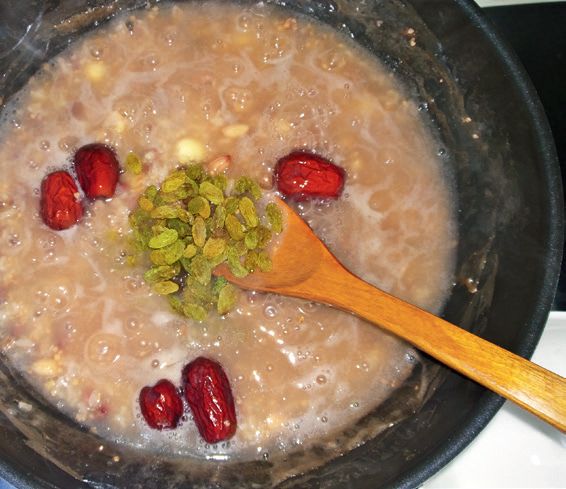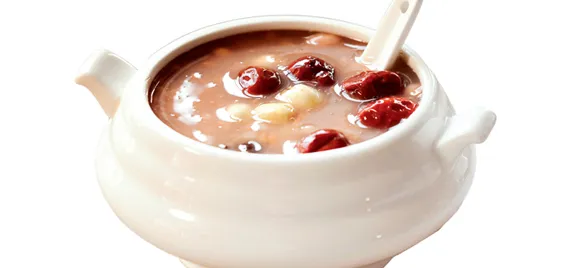A look at China’s favorite sweet porridge, the ‘laba’ or Buddha porridge
Amidst the gluttony-inducing holiday season, labazhou (腊八粥) is a simple, humble dish that keeps you connected to tradition and the true holiday spirit. Laba refers to the Laba Festival, which falls on the eighth day of the 12th lunar month on the Chinese calendar (January 27 for 2015), and zhou is your everyday porridge—a nourishing comfort food eaten across the country. The specific ingredients of laba porridge may differ from town to town, but it’s usually a mixture of different grains, beans, nuts, and dried fruits.
Laba porridge was first cooked as a sacrifice for ancestors and gods during Laba Festival as a part of winter worship. In an agricultural society, the 12th month or layue (腊月) was a time when families ate their stores from the harvest season. Cooking a porridge with rich and varied ingredients is a way to celebrate a prosperous harvest for the year, in hopes of a better one to follow. Also, laba porridge was popular more than a thousand years ago in the Song Dynasty (960-1279) when its mention in historical records first appeared. At the time, royal family members would grant this dish to their courtiers and officials, and ordinary families shared it with relatives and friends for good luck.
Just like Christmas and saturnalia, when Buddhism arrived in China, it stamped its own influence on this local tradition. For Buddhists, Laba Festival is also Buddha’s Enlightenment Day. According to Buddhist texts, Siddhārtha Gautama became emaciated and weak during his practice, then a village girl offered him milk and rice pudding to nurture him back to health. He later sat under a peepal tree and attained enlightenment after 49 days of meditation. Chinese Buddhism believes the eighth day of the 12th month to be just that day. Porridge with rice, dried fruits, and other ingredients has also become a traditional offering to the Buddha. Temples and monasteries also maintain the custom of sharing porridge with their disciples, believers, and the poor. As such, laba porridge is also known as “Buddha porridge”.
In the Qing Dynasty (1616 – 1911) when Tibetan Buddhism had a strong influence over the royal family, laba porridge was a particularly serious matter during the Laba Festival. On the first day of the 12th month, the Imperial household would send fuel and ingredients to Yonghegong Lama Temple, the imperial temple, which is still located at Dongsi District inside the Second Ring Road in today’s Beijing. The temple keeps a copper cauldron, half a meter deep and two-meters in diameter, just for the purpose of cooking laba porridge. The royal laba porridge was certainly luxurious— with the finest cream, millet, glutinous rice, dates, walnuts, longans, sunflower seeds, raisins and so on. On the sixth day, the emperor would send a porridge-offering official and his team to oversee the preparation, and on the morning of the seventh day, the stove would be lit and the cauldron would boil until the early morning of the festival. The first pot was for the Buddha, the second for the emperor and his court, the third for high officials and grand lamas, the fourth for other officials and provincial senior officials, the fifth for all the lamas at Yonghegong, and the final pot was for the common people to share.
The tradition of cooking and sharing laba porridge is still alive in today’s Yonghegong where everyone can get a bowl of the nourishing zhou for free on the morning of the Laba Festival. Just make sure to be patient; in 2014, the temple shared 99 pots of porridge with over 4,500 pilgrims and tourists with many of them waiting in line as early as five in the morning. But, for the auspicious labazhou and good luck in the new year, there’s nothing like a bit of laba porridge to stave off the winter cold.
INGREDIENTS
30g glutinous rice 糯米
30g millet 小米
30g red beans 红豆
20g raisins 葡萄干
20g chestnuts 板栗
20g peanuts 花生
20g lotus seeds 莲子
10g red dates 红枣
20g longan fruit 桂圆
100g sugar 白糖
2,500ml water 水
COOKING STEPS
1. Peel chestnuts and longan. Sok glutinous rice in water overnight. Soak other ingredients for a few hours to prepare them for cooking.

2. Add red beans, lotus seeds, peanuts, millet, and chestnuts to a boiling pot. Boil on medium heat until the ingredients soften.

3. Add glutinous rice, red dates, and longan, and switch to a low heat.

4. Continue to boil for three hours. While boiling, remember to stir to prevent sticking and to add water when necessary. Add raisins when it’s nearly done.
 5.Add sugar, stir, and serve hot.
5.Add sugar, stir, and serve hot.

Photographs by Getty (master), Liu Jue (cooking steps).












